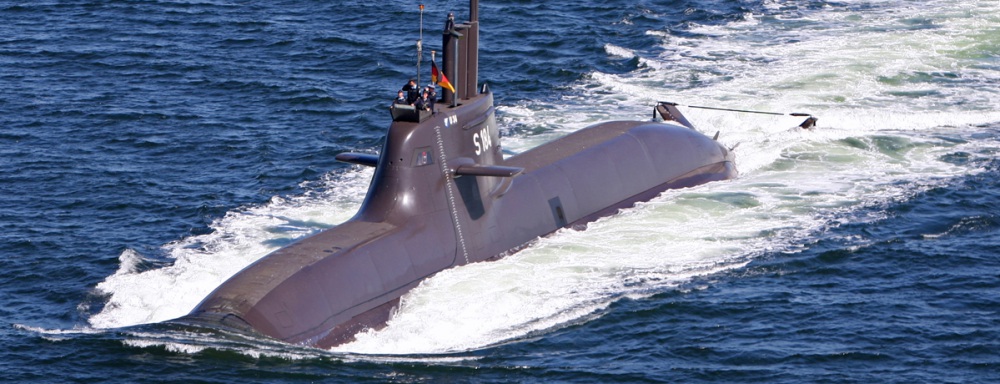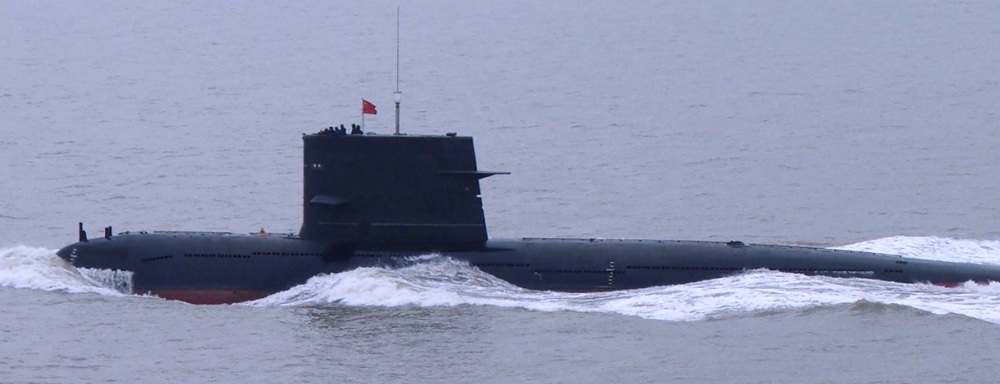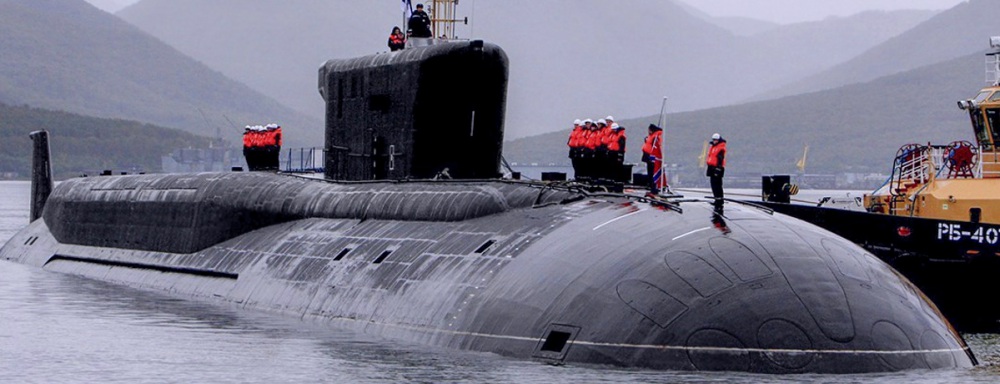
About the image
Capabilities at a Glance
The German Navy currently operates a flotilla of six new hybrid diesel-electric/fuel cell air independent propulsion (AIP) Type 212A submarines, commissioned between 2004 and 2015.1 For a period of time between 2017 and 2018 all of Germany’s submarines were inactive due to a variety of maintenance needs, but as of today all vessels have reentered active service.2
Total Submarines in Fleet: 6
-
Ballistic Missile Submarine (SSBNs): 0
-
Nuclear-Powered attack submarines (SSNs): 0
-
Diesel-electric attack submarines (SSKs): 6
-
Air-independent propulsion (AIP) enabled: 6/6
Submarines
History
During the past decade, the German Navy has expanded its operating area to cover the littoral waters of Northern Europe, the North Atlantic, and the Mediterranean Sea.3 To meet these demands, Germany developed a new class of submarines that could operate in both the open sea and littoral waters.4 The new Type 212A has a greater range, diving depth, and displacement than its predecessor. It also features improved communications systems and reconnaissance capabilities.5 All 212A vessels are equipped with AIP technology developed by the German corporation Siemens which allows the submarines to submerge for longer periods of time.6
Modernization and Current Capabilities
In support of new operational priorities, Germany plans to equip the 212A with a land-attack capability.7 The Interactive Defence and Attack System for Submarines (IDAS) utilizes a wire-guided missile to engage helicopters and mobile targets on shore.8 In May 2013 Turkish company Roketsan, Germany company Thyssenkrupp Marine Systems, and German arms manufacturer Diehl Defence signed an agreement to jointly develop the IDAS missile.9 A major impediment to the development of this technology is defense budget cuts that have stalled the program.10
In October 2017, the U35 damaged its rudder during a diving maneuver and joined three other 212A boats in the Kiel shipyard. However, by December 2018 the U36, U31, and U33 were able to return to sea. In May 2019 the U-36 ran aground while departing the Royal Norwegian Navy base of Haakonsvern.11
In July 2021, Germany began a joint project with Norway to develop the 212CD.12 The German navy ordered two of these ships and the Norwegian navy ordered six. The German ship builder TKMS is working with Kongsberg, a Norwegian ship builder, in order to develop and construct the 212CD. Construction of the first submarine is scheduled for 2023, and will be completed by 2029.13
Ship Biographies
Class 212A
Germany possesses six of Class 212A diesel-electric attack submarines and all are equipped with air-independent propulsion (AIP) system. These submarines are about 56 meters long with a 7-meter-wide beam and can travel up to 20 knots when submerged. Their weapons systems can fire torpedoes using six 533mm torpedo tubes.14
Class 212CD
These submarines will have a surface displacement of 2,500 tons, a 65% increase from the 212A. They will be 73 meters in length, 10 meters in diameter, and 2 meters tall. This large increase in size is due to the 212CD being enclosed in an outer hull. This outer hull is shaped to avoid active sonar. It follows a similar principle as stealth aircraft and has a flat exterior in order to minimize the signal that is bounced back to enemy ships.15
Import and Export Behavior
Imports
Germany does not import submarines.
Exports
German naval shipyards export submarines to countries all over the world.16 The ThyssenKrupp Marine Systems (TKMS) group, which includes Howaldtswerke-Deutsche Werft (HDW), Atlas Elktronik, and Hellenic Shipyards Company in Greece, offers four types of non-nuclear submarines for export: Type 209, Type 212A, Type 214, and Type 218SG.
Type 209 submarines are diesel-electric patrol vessels. HDW has exported over fifty Type 209 submarines to a dozen countries, including Argentina, Brazil, Chile, Colombia, Greece, India, Indonesia, Israel, South Korea, and Turkey.17 In 2004, Portugal ordered two Type 209 vessels (fitted according to Type 214 specifications), which were delivered by HDW in late 2010.18 More recently, TKMS contracted to help upgrade Peru’s four Type 209 submarines in a €40 million deal in 2016.19
Type 214 submarines are hybrid diesel-electric/AIP long-range submarines. They incorporate design features from Type 209 and 212A vessels and have been sold to a number of countries, notably South Korea, Greece, and Turkey.20 South Korea, as a part of their Korean Attack Submarine Program (KSS), is in the process of adding nine Type 214 vessels to its existing fleet of nine Type 209 class submarines. Hyundai Heavy Industries (HHI) and Daewoo Shipbuilding & Marine Engineering (DSME), two companies that are planning to merge into one shipbuilding company, are building the vessels with assistance from HDW.21 Two of the nine have been launched.22
Germany also exports modified versions of its Type 212 A and Type 214 submarines, known as the Dolphin-class and the AIP Dolphin 2-class respectively, to Israel. These vessels are longer in length and have greater underwater autonomy capabilities.23 In October 2017, Germany and Israel signed a memorandum of understanding for Germany to provide three more Dolphin-class submarines starting in 2027 to add to Israel’s arsenal of six Dolphin-class submarines.24
Type 218SG submarines are hybrid diesel-electric/AIP vessels with longer endurance and features to silence operations. They are modeled after the Type 214 with features from the 212A.25 The Republic of Singapore’s Navy (RSN) ordered four Type 218SG submarines in 2013 in a $2.18 billion contract with TKMS.26 The first boat will be delivered in 2021.27
Explore the Collection
Australia Submarine Capabilities
Brazil Submarine Capabilities
Chile Submarine Capabilities
China Submarine Capabilities
France Submarine Capabilities
Your are currently on
Germany Submarine Capabilities
Greece Submarine Capabilities
India Submarine Capabilities
Indonesia Submarine Capabilities
Iran Submarine Capabilities
Israel Submarine Capabilities
Italy Submarine Capabilities
Japan Submarine Capabilities
Malaysia Submarine Capabilities
Netherlands Submarine Capabilities
North Korea Submarine Capabilities
Pakistan Submarine Capabilities
Russia Submarine Capabilities
Singapore Submarine Capabilities
South Korea Submarine Capabilities
Sweden Submarine Capabilities
Taiwan Submarine Capabilities
United States Submarine Capabilities
Submarine Detection and Monitoring: Open-Source Tools and Technologies
Stay Informed
Sign up for our newsletter to get the latest on nuclear and biological threats.
More on
United States Submarine Capabilities
Overview of the United States' submarine capabilities and import-export behavior.

China Submarine Capabilities
A highlight of global trends in the sale and acquisition of diesel- and nuclear-powered submarines by country with capabilities, imports and exports. (CNS)

Russia Submarine Capabilities
Overview of Russia's submarine capabilities and import-export behavior.
Glossary
- SSBN
- Ship, Submersible, Ballistic, Nuclear: A hull classification for a submarine capable of launching a ballistic missile. The "N", or nuclear, refers to the ship's propulsion system. SSBN's are generally reserved for strategic vessels, as most submarine launched ballistic missiles carry nuclear payloads. A non-strategic vessel carries the designation SSN, or attack submarine.
- Diesel-electric submarine
- Diesel-electric submarine: A submarine with a diesel-electric transmission. Diesel-electric transmissions require access to oxygen for the diesel generator to charge the submarine’s batteries or drive the motor. This type of submarine is thus louder and must surface more frequently than a nuclear-powered submarine. A diesel-electric submarine can fire conventional cruise missiles against land targets, and in theory, can also carry nuclear-tipped cruise missiles. Diesel-electric submarines are significantly cheaper to build and purchase than nuclear-powered vessels, which makes them the vessel of choice for smaller navies.
- Air Independent Propulsion Technology (AIP)
- Air Independent Propulsion Technology (AIP): A propulsion system that uses liquid (or compressed) oxygen or hydrogen fuel cells, thereby allowing submarines to stay submerged for longer periods without the need for external sources of oxygen. This increased endurance also increases a submarine’s survivability.
Sources
- “Submarine Forces, Germany,” Jane’s Underwater Warfare Systems, 5 July 2011, www.janes.com; Sebastian Baak, “Hochmodernes U-Boot is Startklar,” NDR, 23 March 2015, www.ndr.de.
- “New European Attack Submarine Programs Pushing Limits of Diesel Technology,” US Naval Institute, 18 October 2021, USNI.org.
- “Submarine Forces, Germany,” Jane’s Underwater Warfare Systems, 5 July 2011.
- Interview with Vice Admiral Hans Lissow, German Naval Chief of Staff, “Naval Chiefs of Staff comments on their adaption to the new security-political situation,” Naval Forces, 2002, Vol. 23, No. 5, pp. 60-65; in ProQuest Information and Learning Company, http://proquest.umi.com; and Interview with Vice Admiral Hans Lissow, German Naval Chief of Staff, “Navies take up the challenge (part 2),” Naval Forces, 1998, Vol. 19, No. 6, pp. 46-54; in ProQuest Information and Learning Company, http://proquest.umi.com.
- Joachim Brune, “Germany’s strength beneath the waves,” EN Vision Magazine, 2002, No. 2, pp 28-31.
- “Equipment order for the 150th submarine: German Navy orders two further submarines with Siemens fuel-cell technology,” Siemens, 5 March 2007, http://info.industry.siemens.com.
- “Submarine Forces, Germany,” Jane’s Underwater Warfare Systems, 5 July 2011.
- “Lenkflugkorper IDAS [IDAS Missile],” Diehl Defence, 2012, www.diehl.com; “HDW, a company within ThyssenKrupp Marine Systems, and DBD receive the Technology Award of the German Defence Industry for IDAS, in the category Exceptional Award,” ThyssenKrupp Press Release, 3 December 2007, www.thyssenkrupp.com; “Submarine Fires German Navy’s First Underwater Missile,” BBC Monitoring Europe – Political, 29 May 2008, www.lexisnexis.com.
- “Roketsan, ThyssenKrupp and Diehl Team up for IDAS Missile Programme,” Naval Technology, 14 May 2013, https://www.naval-technology.com.
- “IDAS Launched Surface to Air Missile System,” Military Technology and Defense News, 14 February 2012, defense-update.com; Sebastien Roblin, “Why Germany’s New Super Stealth Submarine Could Take on Any Navy,” The National Interest, 6 June 2017, http://nationalinterest.org.
- “German Navy Type 212A Submarine, U-36, Runs Aground While Departing Norwegian Navy Base,” DefPost, 17 May 2019, https://defpost.com.
- “Type 212CD Submarines, Germany,” Naval Technology, 28 July 2021, navaltechnology.com.
- “TKMS Milestones Announced,” European Security and Defense, 9 July 2021, Euro-SD.com.
- “Unsere Uboote,” Marine, 6 April 2019, www.marine.de.
- “Radical New Stealth Submarine, Type-212CD, Will Be Much Larger,” Naval News, 14 September 2021, navalnews.com.
- Dieter Hanel, “The German defense industry,” Military Technology, August/September 2003, Vol. 27, No. 8/9, pp. 19-30; in ProQuest Information and Learning Company, http://proquest.umi.com.
- “Executive Overview: Underwater Warfare Systems,” Jane’s Underwater Warfare Systems, 24 December 2010.
- “Portugal Orders Two Class 209 PN Submarines,” Deagel, 22 April 2004, www.deagel.com; “Portugal Takes Delivery of Second Sub,” UPI, 29 December 2010, www.upi.com.
- “Peruvian Navy Begins Type 209/1200 Submarine Modernization,” Naval Today, 14 December 2017, https://navaltoday.com.
- “HDW wird grosster Hersteller von U-Booten,” Frankfurter Allgemeine Zeitung, 23 September 1999; in Lexis-Nexis Academic Universe, http://web.lexis-nexis.com; Uta Harnischfeger, “Groups battle to control HDW,” Financial Times, 9 July 2003; in Lexis-Nexis Academic Universe, http://web.lexis-nexis.com; Anthony Watts, Jane’s Underwater Warfare Systems: 2003-2004 (Coulsdon: Jane’s Information Group, 2002), pp. 31-47; “ThyssenKrupp Marine Systems- Restructuring largely complete/Strategy confirmed by Turkish submarine contract,” ThyssenKrump, 1 July 2011, www.thyssenkrupp.com.
- “South Korea: HHI Take over of DSME to Create Global Shipbuilding Giant,” Naval Today, 8 March 2019, https://navaltoday.com.
- “Navy launches 2nd 3,000-ton submarine Ahn Mu,” Korea.net, 11 November 2020, https://korea.net.
- “Israel’s Navy Recieves the Fifth Dolphin Submarine,” Defense Update, 19 April 2013, defense-update.com; “Israel gets fifth ‘nuclear-capable’ sub,” RT, 14 May 2013, rt.com.
- Kyle Mizokami, “Meet Israel’s Super Dolphin-Class Submarine (Armed with Nukes?) “The National Interest, 27 January 2019, https://nationalinterest.org; Opall-Rome, Barbara. “Israel Signs MoU for 3 German Submarines Amid Shipyard Investigation,” Defense News, 23 October 2017, www.defensenews.com.
- Ridzwan Rahmat, “TKMS beings work on Singapore’s third and fourth Type 218SG submarines,” Jane’s 360, 16 January 2018, www.janes.com.
- Otfried Nassauer and Gordon Repinski, “The German Defense Industry Discovers Asia,” Spiegel Online, 7 January 2014, www.spiegel.de.
- Mike Yeo, “Singapore’s First New Submarine Christened at Thyssenkrupp Shipyard,” Defense News, 19 February 2019, www.defensenews.com.
